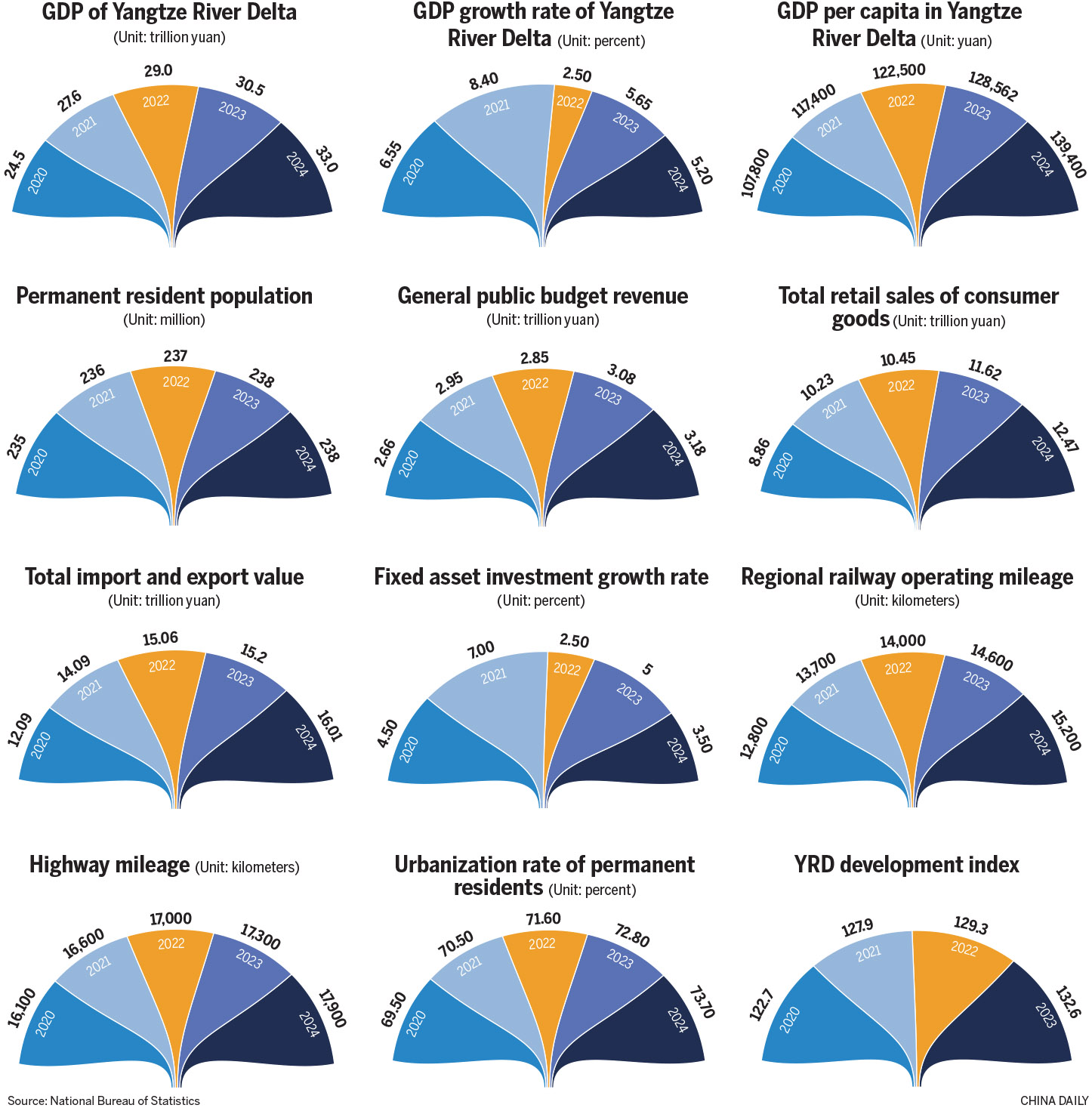Pioneering models set pace for nation's other regions to follow

'Embodied intelligence" is undoubtedly the buzz phrase in the tech world this year, according to many industry experts.
In late September, the annual China International Industry Fair in Shanghai witnessed the giant steps made in this emerging technology, which integrates artificial intelligence into physical entities such as robots to enable them to perceive, learn and dynamically interact with their environment.
The fair — which attracted 3,000 companies from 28 countries and regions — debuted more than 1,000 new technologies and products. It also saw the establishment of an industrial consortium to facilitate the development of embodied intelligence in the Yangtze River Delta region.
The first group of companies and institutes joining the consortium includes Shanghai-based robotics company Fourier Intelligence, Standard Robots (Wuxi), new mica composite materials manufacturer Zhejiang Glory, and Wuxi-based Jiangnan University.
READ MORE: Shanghai to enhance linkage between AI, manufacturing
Cheng Peng, Party secretary of the Shanghai Municipal Commission of Economy and Informatization, said that Shanghai has played a key role in leading the development of high-end industries such as embodied intelligence after the city positioned itself as an innovation hub. By leveraging resources from all over the world, Shanghai can help build the Yangtze River Delta region into a comprehensive demonstration and pioneering zone for embodied intelligence, he added.
Other areas of the region also have their respective strengths.
Ma Xuan, chief researcher of the China Academy of Urban Planning& Design's Shanghai branch, said Jiangsu has taken the lead in issuing jointly compiled academic papers, which can be largely attributed to the many well-established universities in the province. In addition, Anhui province has sped up the industrial application of innovations achieved in the lab, she said.
Lu Xiongwen, dean of the School of Management at Fudan University, said disruptive technologies such as artificial intelligence are reshaping business logic.
Industrial upgrading, which was resource reliant, is now more dependent on coordinated development within an ecosystem.
As seen in numerous cases, coordination among companies, research institutes, and governments in the Yangtze River Delta region provides a replicable model for other parts of China. This in turn provides more momentum for China's high-quality economic development, he said.

Leading by example
The Yangtze River Delta region — comprising Shanghai, and Jiangsu, Zhejiang and Anhui provinces — has seen its leading position in China's technological innovation become increasingly evident, according to a report released by the Chinese Academy of Science and Technology for Development in late September.
The region accounted for over 30 percent of China's research and development expenditure, industry experts, high-value patents, and high-tech exports. Nearly half of the country's international technology income is generated in the region, the report said.
Liu Dongmei, the academy's Party secretary, said coordinating technological innovation is never the job of one government department. Various industries should be included and resources efficiently directed across different administrative regions, she said.
One example in the Yangtze River Delta region is the production of Tesla electric vehicles. While Shanghai provides the chips for the smart-driving technology, Jiangsu supplies the batteries, Zhejiang does the body casting, and Anhui is responsible for the final vehicle assembly.
The region is home to industrial clusters of three emerging technologies — integrated circuits, biomedicine and AI. Nearly 60 percent of China's IC industrial output, one-third of the AI industrial output, and one-third of biomedicine are all generated in the region.
The emphasis on technological innovation, which has been a common approach among local governments, has paid off.
The region's GDP topped 33 trillion yuan ($4.64 trillion) in 2024, surpassing that of Japan. Taking up just 4 percent of China's total area, the region contributed nearly 25 percent of the country's GDP.
Other regions have also noticed the power of coordinated technological innovation. The Beijing-Tianjin-Hebei region saw its combined R&D expenditure reach 445.8 billion yuan last year, according to the CASTED report. The area's R&D expenditure intensity, or the ratio of R&D expenditure to GDP, approached 4.3 percent — 1.6 times the national average.
Similar examples can be found in the Guangdong-Hong Kong-Macao Greater Bay Area.
Guangdong province's R&D expenditure hit 510 billion yuan in 2024, according to National Bureau of Statistics data, topping the 500-billion-yuan threshold for the first time and securing its position as the largest R&D spender among all provincial-level regions for the ninth consecutive year.
The Qianhai Shenzhen-Hong Kong Youth Innovation and Entrepreneur Hub, located in the western part of Shenzhen, Guangdong, is only 30 minutes drive from central Hong Kong. It has served as the first stop for many Hong Kong startups aiming to expand their footprint in the Chinese mainland.
Since the hub's establishment in 2014, a total of 1,450 startups have been nurtured there, with 1,028 of them originating in Hong Kong, Macao and other places.
The progress in the Yangtze River Delta region is reliant on the shared targets of the local governments, which are translated into coordinated development plans and co-working mechanisms.
The coordinated development of the Yangtze River Delta region was elevated to a national strategy in 2018, but its inauguration in November 2019 as demonstration zone for the region's green and integrated development was a major step toward it coming up with concrete measures.
By the end of 2024, over 112 coordinated institutional innovations had been nurtured in the zone. Among those, 38 have been promoted nationwide, in areas covering ecological conservation, land management, cross-regional flow of production factors, and integrated tax collection and administration.
In July 2022, a collaborative plan to seek technological breakthroughs in the Yangtze River Delta region was released, encouraging new systems for innovation and allowing multiple entities to invest in technologically advanced projects.
So far, the plan has supported 87 projects, including fundamental research projects.
Up to 1.7 billion yuan of investment has been directed to projects under the plan, of which 340 million yuan came from the fiscal budgets of local governments.
Digital driver
Looking forward, Dong Xuebing, deputy director of the Research Center for Regional Coordinated Development at Zhejiang University, said the digital economy will serve as a major growth engine.
A pilot program for digital rights confirmation should be quickly built in the region, he suggested. Through the protection of digital intellectual properties, confirmation of rights, anti-monopoly regulations, and industrial policies the region's digital economy can seek sustained growth.
Liu Zhibiao, executive director of the Yangtze Industrial Economic Think Tank, a part of Nanjing University, said companies should be encouraged to build industrial models that suit the integrated development of the region.
ALSO READ: Business zone to deepen international cooperation
Mergers and acquisitions, for instance, should be better supported to achieve this goal. In this way, policy differences can be minimized and international industrial clusters built in the region, which are also outcomes conducive to achieving the country's major strategies, he said.
The Yangtze River Delta region and the Pearl River Delta region are the two major growth engines for China, shouldering great responsibility for the country's sustained development, said Zheng Yongnian, dean of the School of Public Policy at the Chinese University of Hong Kong, Shenzhen.
While China is undergoing the transition from old to new economic drivers — with technological innovation playing an increasingly important role — the country needs to strengthen fundamental research, nurture more transformation of technologies and provide stronger financial support, he said.
Therefore, deeper institutional reform should be conducted and barriers further broken. More autonomy should be given to regions so that they can advance technological innovation in more flexible and efficient ways, said Zheng.
Contact the writers at shijing@chinadaily.com.cn


